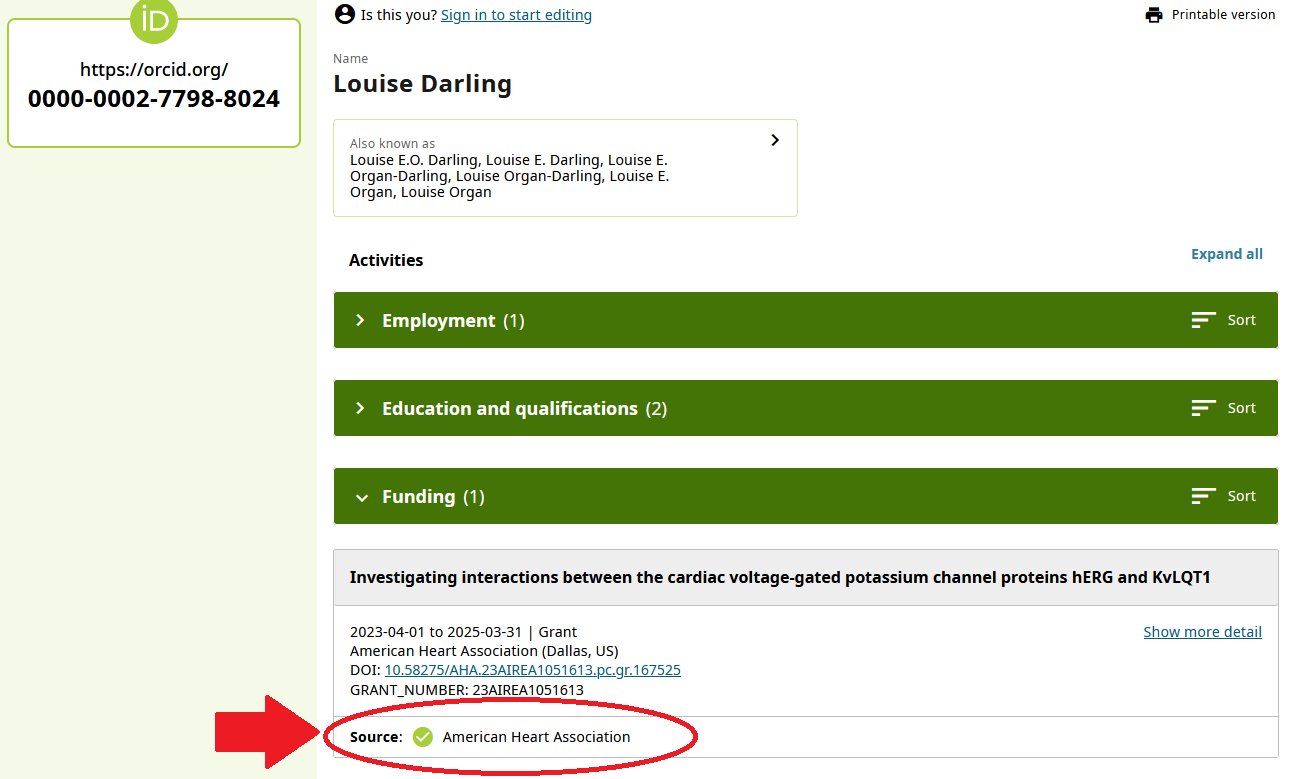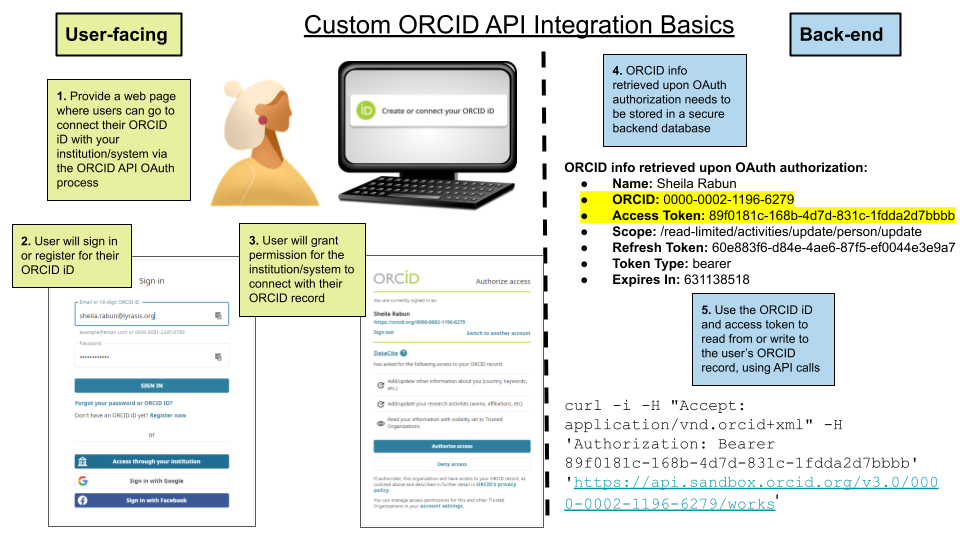On November 9, 2021, the ORCID US Community consortium hosted a Community Call presentation on the importance of ORCID and how ORCID intersects with the priorities and activities of funders. Belinda Orland, Senior Manager for Research Operations with the American Heart Association (AHA) and Kristen Mueller, former Scientific Program Director with the Melanoma Research Alliance (MRA) presented case studies on how their organizations use ORCID in their funding workflows.
This blog post will (1) introduce readers to the ways that funders can use ORCID and how it can benefit them, (2) explain why funders should start using ORCID in their workflows, and (3) share case studies on how the American Heart Association and the Melanoma Research Alliance have been using ORCID in their funding workflows.
For readers interested in this presentation, and webinar, the Community Call was recorded and made available to ORCID US Community members. For more information, contact orcidus@lyrasis.org.
How Funders can use ORCID
Funders often require researchers to fill out various different forms to submit grant applications, or for the funding agency to give out awards. This workflow process can take time – with ORCID, these workflows can be streamlined, and both the funding agency and their researchers can benefit in a number of ways:
If funders use the ORCID member API to connect with awardees’ and reviewers’ ORCID records, they can:
- Uniquely identify researchers and stay connected with alumni
- Streamline data collection of researchers’ activities prior to and after the grant period, to gauge return on investment
- Confirm relationships with researchers in the wider research landscape
- Save researchers’ time and reduce errors when filling out forms
- Assist researchers in improving their visibility and discoverability
- Standardize how researchers input the funding agency’s name and data in their records
With ORCID, the integrity of funding workflows can be improved, helping reduce administrative burden and increase accuracy in reports and submissions.
In funding systems, such as ProposalCentral, SmartSimple or SciENcv, importing researcher information from ORCID for progress reports and applications saves time and makes data entry easier.
For example, using ProposalCentral, the researcher can log in directly with their ORCID iD, shown below in Figure 1. The funder will collect the ORCID iD and request access to the researcher’s record.

Figure 1: An example of how researchers can sign into ProposalCentral using their ORCID iD
The researcher can then choose to authorize the funder as a trusted organization on their ORCID record to retrieve data from and/or write data to their ORCID record. Once given permission, the funder can collect necessary data from the researcher’s ORCID record for their application process, populating the application or form automatically rather than having the researcher manually enter their information. For example, in Figures 2 and 3, SciENcv allows a researcher to import data from their ORCID record to populate their SciENcv biosketch with two steps.

Figure 2: An example of how researchers can select ORCID as an external source to import data from ORCID to SciENcv (Step 1)

Figure 3: An example of how researchers can choose which works information they want to import from ORCID into their SciENcv biosketch (Step 2)
When a researcher authorizes a funder to access their ORCID record, funders can add award information to the researcher’s ORCID record automatically, shown below in Figure 4, validating the award and yielding more authority and credibility to the researcher’s record. Funders who push data to a researcher’s ORCID record can standardize how their data and organization’s name appears; this helps make funding award information more trustworthy.

Figure 4: An example of how funding awards will appear in a researcher’s ORCID record when added by a funding agency using the ORCID member API
However, not all software systems have built-in ORCID integrations. Funders that are not using software systems with ORCID integrations can create a custom integration. For a software system that the funding agency is already using, a custom integration with the ORCID member API will allow that system to write to ORCID and read information from ORCID.
For questions about creating and using a custom integration, contact orcidus@lyrasis.org.

Figure 5: An introduction to the basics of custom ORCID API integrations
If using a software system without an integration, or developing an ORCID custom integration is not an option, funders can use ORCID’s Affiliation Manager tool, however, this has limitations. The Affiliation Manager cannot write funding to an ORCID record, it can only write affiliation information: education, employment, invited positions, distinctions, membership or service information. This could be helpful if the funding organization has any of these types of relationships with researchers.
It is recommended that a funder write award information to the funding section of an ORCID record and peer review information to the peer review section of an ORCID record; this helps keep information consistent within ORCID records for awardees in their future research pursuits. At this time, this can only be done with an ORCID integrated system, like ProposalCentral, or with a custom integration. ORCID has a list of ORCID integrated systems available on their website. The ORCID US Community also has a list of common systems with information on which systems have ORCID integrations.
While it is ideal to have funding information added to researchers’ ORCID records directly by the funding organization via the ORCID API, in ORCID, funding data can also be added by researchers manually. This process is outlined in this guide: How Researchers Can Add Funding Data into their ORCID Records.
American Heart Association
Belinda Orland from the American Heart Association (AHA) showcased to the ORCID US Community how AHA has been using ORCID in their funding workflow.
Beginning in 2018, AHA required ORCID identifiers for their awardees. However, AHA was not yet a member of ORCID; they could not verify these iDs by connecting ORCID with their funding system.
Orland shared that, after joining the ORCID US Community in June 2020, they implemented ProposalCentral as their Grants Management system. Since they already required ORCID iDs from their applicants, the next step, Orland explained, was to encourage awardees to make AHA a trusted organization. From there, they could upload AHA award information to researchers’ ORCID records.
AHA provided instructions to their applicants on how to set up an ORCID iD and how to make AHA a trusted organization, and by 2023, 92% of new awardees had made AHA a trusted organization.
AHA began to push funding award information to ORCID records in July 2021, and as of February 2024, AHA has improved their workflow further by pushing both award information and peer-review participation to ORCID records on a monthly basis.
AHA continues to encourage the adoption of ORCID amongst their awardees and researchers in the overall academic community.
Melanoma Research Alliance
Kristen Mueller from the Melanoma Research Alliance (MRA) also shared with the ORCID US Community how MRA has adopted ORCID in their funding workflow.
MRA was founded in 2007 and had funded 380 research projects as of November 2021. Mueller explained that MRA adopted persistent identifiers (PIDs) to:
- Reduce administrative burden on their applicants and awardees during the application process, when submitting progress reports, etc.
- Increase transparency and discoverability of MRA research grants
- Make research outcomes from MRA grants accurately identifiable
- Allow MRA to capture more complete, timel, and accurate data to inform their scientific strategy and report MRA-funded advancements to their key stakeholders
In 2020, MRA began to create Grant DOIs through Crossref for MRA awards. They asked awardees to use them to link information together for future evaluation purposes.
MRA created a required deliverable that asked awardees to create an ORCID iD and, at the same time, to authorize MRA as a trusted organization. Mueller explained that to activate their awards, awardees must submit this deliverable, visible in ProposalCentral as shown in Figure 6.

Figure 6: An example of how MRA uses ProposalCentral to authorize ORCID iDs and link information to the funding system
Mueller also shared that MRA conducts an evaluation project every three years to collect data and audit their workflow process. This project will allow them to determine how successful the new ORCID workflow has been for their organization.
Federal Funder Policies and PIDs
Funding organizations and researchers seeking research funding from United States federal government agencies should also know about NSPM-33.
The National Security Presidential Memo 33 (NSPM-33) is a mandate for the establishment of research security practices to protect against interference and exploitation at research institutions receiving federal funding. It requires all federal research funding agencies to strengthen and standardize disclosure requirements for federally funded awards. This means that these federal agencies will be required to create a policy to address “digital persistent identifiers” or “persistent identifiers” (PIDs) for individual researchers. Currently, ORCID is the only PID for individuals that matches the criteria outlined in the NSPM-33 Guidance.
On February 14 2024, the White House Office of Science and Technology Policy (OSTP) also released a policy statement on federal funding agencies and the use of Common Forms in their workflows. Applicants using the Common Forms should include a persistent digital identifier that meets the NSPM-33 requirements (as ORCID does).
For more information about NSPM-33 and its importance with regard to ORCID, readers can view this NSPM-33 guide or contact orcidus@lyrasis.org.
ORCID matches the criteria defined in NSPM-33 to uniquely identify individuals and help with disclosures, but there are other PIDs that can help improve funding workflows, especially when these PIDs are included in ORCID record metadata.
Other identifiers that interoperate with ORCID and are important for funders to know are:
- Crossref Grant ID is a DOI (digital object identifier) used to identify and disambiguate grants/awards
- Crossref Funder ID (Fundref) is an identifier used to identify and disambiguate funding organizations. This will soon transition to ROR.
- Research Organization Registry (ROR) is an open access registry for identifying and disambiguating research organizations.
To learn more about these identifiers and how they work together, please see our blog on: How Persistent Identifiers Work Together in the Research Ecosystem.
Resources
For researchers and organizations wishing to learn more about how ORCID influences funding workflows, here are some helpful resources:
- How Researchers Can Add Funding Data into their ORCID Records
- ORCID for Funding Organizations
- Funder and Grant workflows
- Recommendations for Funders (2023)
- Guide for Funders to Support FAIR Workflows
- DimensionsWizard Data Sources
- Crowd-Sourced Spreadsheet showing Funder ORCID usage
- ORCID and PIDs
- How Persistent Identifiers Work Together in the Research Ecosystem
- How to add funding to an ORCID record
